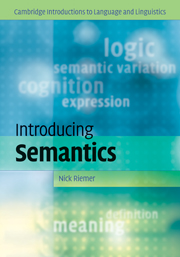Book contents
- Frontmatter
- Contents
- Note to the reader
- 1 Meaning in the empirical study of language
- 2 Meaning and definition
- 3 The scope of meaning I: external context
- 4 The scope of meaning II: interpersonal context
- 5 Analysing and distinguishing meanings
- 6 Logic as a representation of meaning
- 7 Meaning and cognition I: categorization and cognitive semantics
- 8 Meaning and cognition II: formalizing and simulating conceptual representations
- 9 Meaning and morphosyntax I: the semantics of grammatical categories
- 10 Meaning and morphosyntax II: verb meaning and argument structure
- 11 Semantic variation and change
- Glossary
- References
- Index
8 - Meaning and cognition II: formalizing and simulating conceptual representations
Published online by Cambridge University Press: 05 June 2012
- Frontmatter
- Contents
- Note to the reader
- 1 Meaning in the empirical study of language
- 2 Meaning and definition
- 3 The scope of meaning I: external context
- 4 The scope of meaning II: interpersonal context
- 5 Analysing and distinguishing meanings
- 6 Logic as a representation of meaning
- 7 Meaning and cognition I: categorization and cognitive semantics
- 8 Meaning and cognition II: formalizing and simulating conceptual representations
- 9 Meaning and morphosyntax I: the semantics of grammatical categories
- 10 Meaning and morphosyntax II: verb meaning and argument structure
- 11 Semantic variation and change
- Glossary
- References
- Index
Summary
CHAPTER PREVIEW
In the previous chapter we looked at some proposals about the types of cognitive operation that underlie semantic ability. In this chapter, we examine some attempts to formalize and model the conceptual representations involved in language. In 8.1 we examine Jackendoff's conceptual semantics, a theory about the cognitive structures behind language and the modes of their interaction. This is followed by a discussion of the treatment of meaning in computational linguistics, which uses computer models of language as an aid to understanding the mental processes involved in language production and understanding (8.2). We will concentrate on the aspects of computational linguistics which give insight into the nature of the task of meaning-processing. We specifically look at WordNet, an online lexical database, at the problems of word-sense disambiguation, and at Pustejovsky's solution to this in his model of qualia structure.
Conceptual semantics
Jackendoff's Conceptual Semantics framework is an important approacl to meaning (Jackendoff 1983, 1990, 1991, 2002, 2007). Conceptual Semantic shares a key commitment with the cognitivist approaches we looked at in the last chapter: Jackendoff rejects any distinction between meaning and conceptualization, stating (2002: 282) that ‘we must consider the domain of linguistic semantics to be continuous with human conceptualization a a whole’. As a result, Jackendoff aims to situate semantics ‘in an overal psychological framework, integrating it not only with linguistic theory bu also with theories of perception, cognition, and conscious experience (1990: 2). Conceptual Semantics differs from Cognitivist approaches, however, in two important ways.
- Type
- Chapter
- Information
- Introducing Semantics , pp. 261 - 286Publisher: Cambridge University PressPrint publication year: 2010



